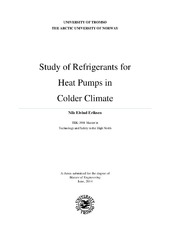| dc.contributor.advisor | Khawaja, Hassan A. | |
| dc.contributor.author | Eriksen, Nils Eivind | |
| dc.date.accessioned | 2015-10-02T14:34:29Z | |
| dc.date.available | 2015-10-02T14:34:29Z | |
| dc.date.issued | 2014-06-01 | |
| dc.description.abstract | The aim for the thesis is to look at the performance of natural refrigerants in heat pumps while operating in a colder climate. The advantage of using natural refrigerants is that they have significantly lower global warming potential (GWP) in comparison to the synthetic refrigerants i.e. hydro fluorocarbons (HFC) and hydro chlorofluorocarbons (HCFC). Natural refrigerants are becoming common to use as a refrigerant in domestic heat pumps however still most household heat pumps use synthetic refrigerants. Due to the harmful impact of synthetic refrigerants, EU regulations are limiting the use of synthetic refrigerants in the future appliances. Similar steps are being taken by other countries around the globe.
The motivation behind this work is to assess the energy requirement in the use of heat pump in colder climate conditions using natural and synthetic refrigerants. For the study, climatic data from Karasjok (69°28′55″N 25°6′18″E) is taken into consideration (eKLIMA, 2014). Karasjok is located in Finnmark, county of Norway. The average temperature in Karasjok over the year can be as low as -1.45 ºC (from the stats of year 2012). | en_US |
| dc.description.abstract | The heat pump analysis was performed on three natural refrigrants, R744 (carbondioxide – CO2), R717 (ammonia – NH3), R290 (propane – C3H8) and one synthetic refrigerant R410A (a 50/50 mixture of HFCs: R32 (difluoromethane – CH2F2) and R125 (pentafluoroethane – CHF2CF3)). R290 and R744 have better performance in colder climatic condition within different analysis segments in single stage as well as two stages heat pump cycles. This shows that natural refrigerants are able to replace the synthetic refrigerants when considering the performance in the colder climate. Analysis also showed that a single stage R290 heat pump is able to cover up to 90% of the heating and hot water supply need on annual basis (data taken for years 2012 and 2013). | en_US |
| dc.description.abstract | The study was conducted in CoolPack©, MS Excel® sheet (Kolsaker, 2013) and log p-h diagrams. The analysis of refrigerants close to transcritical pressure was performed in CoolPack©. The analysis of two-stage refrigeration cycle was performed using CoolPack© and MS Excel® (Kolsaker, 2013). The results were compared using log p-h diagrams.
The conclusion of the study is that with the use of natural refrigerants, it is possible to save energy. In addition, natural refrigerants have far lower environmental impact than its synthetic counterparts. Therefore, it is suitable to use natural refrigerants in replacement of synthetic refrigerants. | en_US |
| dc.identifier.uri | https://hdl.handle.net/10037/8181 | |
| dc.identifier.urn | URN:NBN:no-uit_munin_7761 | |
| dc.language.iso | eng | en_US |
| dc.publisher | UiT The Arctic University of Norway | en_US |
| dc.publisher | UiT Norges arktiske universitet | en_US |
| dc.rights.accessRights | openAccess | |
| dc.rights.holder | Copyright 2014 The Author(s) | |
| dc.rights.uri | https://creativecommons.org/licenses/by-nc-sa/3.0 | en_US |
| dc.rights | Attribution-NonCommercial-ShareAlike 3.0 Unported (CC BY-NC-SA 3.0) | en_US |
| dc.subject.courseID | TEK-3901 | en_US |
| dc.subject | VDP::Teknologi: 500::Berg- og petroleumsfag: 510::Petroleumsteknologi: 512 | en_US |
| dc.subject | VDP::Technology: 500::Rock and petroleum disciplines: 510::Petroleum engineering: 512 | en_US |
| dc.subject | Technology and Safety in the High North | en_US |
| dc.title | Study of Refrigerants for Heat Pumps in Colder Climate | en_US |
| dc.type | Master thesis | en_US |
| dc.type | Mastergradsoppgave | en_US |


 English
English norsk
norsk


